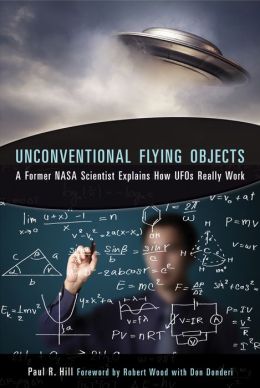I’ll begin with a warning: This book is not for the faint of heart. I’m not talking about people who are afraid of aliens, but people who are afraid of math. I made it through college calculus without too much hair-pulling and as I read, I had to slow down and work my way through the mathematics one bit at a time. Fortunately, you don’t actually have to understand the math in order to appreciate the explanations Paul Hill gives. In fact, I suspect you could skim over all his equations and still enjoy the book. So please don’t let the warning stop you. This is a truly fascinating book.
Hill worked for NASA for many years, but it’s not a surprise that the government agency muzzled him regarding his work on flying saucer propulsion systems and other issues of physics regarding UFOs. “Clearly,” he writes, “I was destined to remain as unidentified as the flying objects.” He spent decades working out possible ways UFOs (which he calls ‘unconventional flying objects’) could fly without violating the known laws of physics. This book, published posthumously by his wife, details all that work and explains very clearly how it’s possible for the various types of UFO craft to do the amazing things they do. Even though Hill’s work demystifies the actual mechanics of UFO operation, to me it makes them even more mysterious – if they don’t violate the laws of physics, then someone, somewhere has some truly amazing technology that we can’t even approach.
Without insisting on any particular identity or origin for UFOs, Hill simply does what good scientists do: he takes the data and figures out how UFOs, as seen by thousands of credible witnesses since the 1940s, can function within the laws of physics that we’re familiar with. He gives a straightforward overview of the types of observations made: shape of object, color, heat or lack thereof, sounds, motions. This book keeps an objective distance, analyzing the data without judgment and providing a really interesting exploration of the observations. It helps that Hill has a sense of humor, occasionally injecting funny remarks among the data and descriptions; though the book is packed full of information, it’s not a dry read.
The book includes photos of UFO sightings, but more interestingly, it also includes photos of a flying platform the author invented in the 1950s. The ‘pilot’ stands atop the platform and guides it by tilting his body. This experiment was part of his work to demonstrate that the tilting and other odd movements UFOs make might be part of their propulsion system. In straightforward language, Hill explains how UFOs can appear (to the human eye) to change direction instantly without breaking the laws of physics, and also how interstellar flight at just-below-light-speed velocity is possible and even practical.
Altogether, this book is fascinating because, unlike every other UFO volume I’ve ever read, it is completely straightforward. There is no wild speculation, but a simple examination of the facts that we are sure of. Hill relegates the most complicated calculations to the appendices at the end of the book, and he explains his methodology and the scientific terms he uses clearly. Take your time to read and understand his explanations, and skip the heavier math if you prefer. This is a truly fascinating book, and well worth the effort required to read it. My only regret is that the author has passed away. I would love to talk with him about his work.
~review by Laura Perry
Author: Paul R. Hill
Hampton Roads Publishing Company, 2014
pp. 429, $24.95

